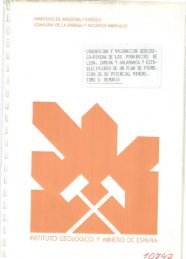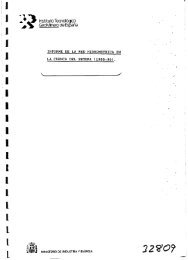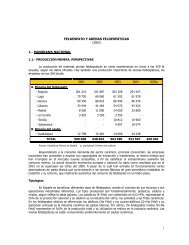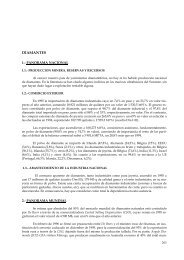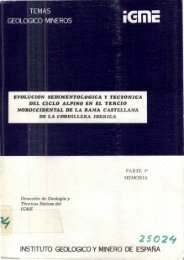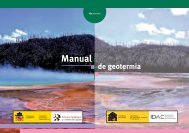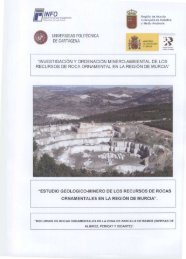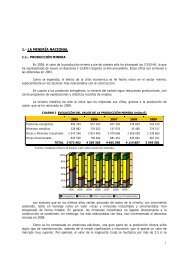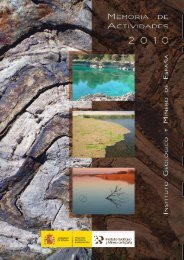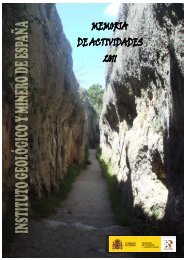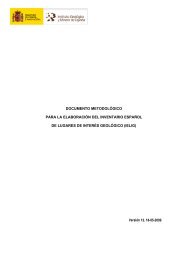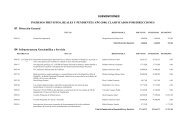mesozoic successions of the betic and iberian ranges - Instituto ...
mesozoic successions of the betic and iberian ranges - Instituto ...
mesozoic successions of the betic and iberian ranges - Instituto ...
Create successful ePaper yourself
Turn your PDF publications into a flip-book with our unique Google optimized e-Paper software.
Figure 27, above. General view <strong>of</strong> <strong>the</strong> Lower <strong>and</strong><br />
Middle Jurassic section <strong>of</strong> Fuentelsaz, unconformably<br />
overlain by <strong>the</strong> Cretaceous.<br />
Figure 28, right. Lower <strong>and</strong> Middle Jurassic transition<br />
at <strong>the</strong> Fuentelsaz Section. The Toarcian-Aalenian<br />
boundary is located some centimeters above <strong>the</strong><br />
central escarpment.<br />
Figure 29, below right. Detail <strong>of</strong> <strong>the</strong> Lower to Middle<br />
Jurassic transition at <strong>the</strong> Fuentelsaz section. The<br />
Toarcian-Aalenian boundary is located around 40 cm<br />
below <strong>the</strong> hammer.<br />
towards <strong>the</strong> Proto-Atlantic or towards <strong>the</strong> Tethys, <strong>and</strong><br />
more tectonically-active stages). The result is a variety<br />
<strong>of</strong> facies, <strong>and</strong> <strong>the</strong> development <strong>of</strong> <strong>the</strong> most important<br />
<strong>and</strong> extensive transgressive episodes <strong>of</strong> <strong>the</strong> Mesozoic,<br />
causing an extension <strong>of</strong> Cretaceous deposits to ra<strong>the</strong>r<br />
distant areas (across <strong>the</strong> Iberian Massif) <strong>of</strong> <strong>the</strong> tectonic<br />
<strong>and</strong> morphological boundary <strong>of</strong> <strong>the</strong> Iberian Range.<br />
These circumstances are <strong>the</strong> origin <strong>of</strong> a stratigraphic<br />
record with specific features: at first, <strong>the</strong>re is a<br />
prevalence <strong>of</strong> terrigenous facies from continental or<br />
coastal environments, which are followed by shallow<br />
shelf carbonate facies, reaching <strong>the</strong>ir highest depth<br />
in <strong>the</strong> Upper Cretaceous, <strong>and</strong> ending near <strong>the</strong> end<br />
<strong>of</strong> <strong>the</strong> Cretaceous with evaporitic facies. There is<br />
also a progressive extension <strong>of</strong> <strong>the</strong> deposits, which<br />
where originally limited to specific areas (Cameros,<br />
Maestrazgo, surroundings <strong>of</strong> <strong>the</strong> Betic Ranges),<br />
but which later occupied <strong>the</strong> whole Iberian Range,<br />
continuing for more than 200 km to <strong>the</strong> east on <strong>the</strong><br />
Iberian Massif. The paleogeographic distribution also<br />
evolved from small <strong>and</strong> isolated sedimentary basins,<br />
to bigger elongated basins (late Early Cretaceous),<br />
up to <strong>the</strong> establishment <strong>of</strong> a single <strong>and</strong> widespread<br />
Cenomanian-Turonian sedimentary basin. Towards<br />
<strong>the</strong> end <strong>of</strong> <strong>the</strong> Cretaceous, <strong>the</strong>re is a short <strong>and</strong> quick<br />
evolution in <strong>the</strong> opposite direction.<br />
Among <strong>the</strong> most representative <strong>and</strong> complete exposures<br />
<strong>of</strong> <strong>the</strong> Cretaceous geological history in <strong>the</strong><br />
Iberian Mountain Range, <strong>the</strong> stratigraphic succession<br />
<strong>of</strong> Sierra de Gudar (Villaroya de los Pinares,<br />
Teruel) has been selected, due to <strong>the</strong> splendid spatial<br />
continuity <strong>of</strong> its exposures (Figure 30), <strong>the</strong> large time<br />
span <strong>of</strong> its stratigraphic record (from <strong>the</strong> Barremian to<br />
<strong>the</strong> Campanian), <strong>the</strong> richness <strong>and</strong> variety <strong>of</strong> facies <strong>and</strong><br />
fossils, <strong>and</strong> <strong>the</strong> natural values <strong>of</strong> <strong>the</strong> area where it is<br />
located.<br />
This exposure is a model for <strong>the</strong> whole Cretaceous <strong>of</strong><br />
<strong>the</strong> Iberian Range, shows good exposure quality, <strong>and</strong><br />
forms a stratigraphic succession with a wide variety<br />
<strong>of</strong> stratigraphic, sedimentological <strong>and</strong> paleontological<br />
records. Its strongest interest lies on it containing<br />
86<br />
Castro, J.M. - García, A. - Gómez, J.J. - Goy, A. - Molina, J.M. - Ruíz Ortíz, P.A. - Sopeña, A.



